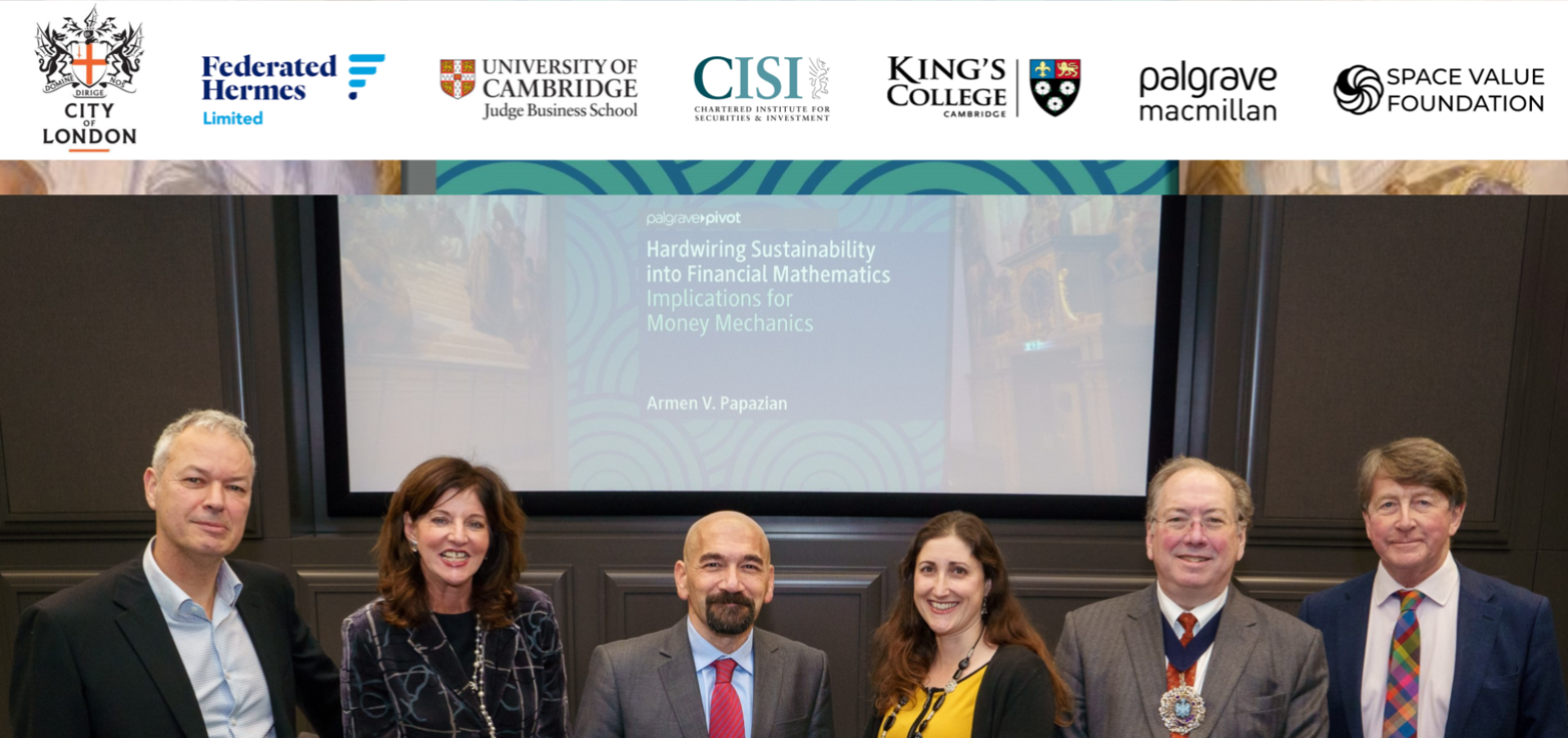
If we are to meet the climate challenges ahead, change course, and give future generations a chance to do better, we must rethink—and re-invent—the very principles, equations, methodologies, data points, and technologies by making a radical and fundamental adjustment to our financial value framework. In short, we must change the way businesses and investments, and their impact, are valued and monitored.
For many decades before the current momentum, sustainable finance was a relatively small niche market, and many in the mainstream finance industry used to treat it as a soft and relatively insignificant segment. Until a few years ago, the finance industry, including central banks, commercial and investment banks, investment funds, asset managers, family offices, sovereign wealth funds, etc., spoke only of the risk adjusted returns of their investments and assets. The risk averse investor was the holy grail of their theoretical and practical models of valuation and investment. In other words, the planet and the environment hardly ever made it into the equation, and as such, the finance industry bears great responsibility for the mess we are in today.
Decades of myopic financial education and practice, have created environmental degradation and climate emergency. We have, generation after generation, imparted a theoretical and practical financial education that dismisses the environment as a qualitative addendum, an externality, an optional consideration to the models focused entirely on the risk and time value of cash flows.
Since 2015, sustainable finance, in all its shapes and forms, has consistently and aggressively moved to the mainstream. Now, everyone in the industry knows we must change, or knows that we must be ready to change, or at the very least, we must start talking about being ready to change. Now, many market participants are keen to take part in the next phase of growth, to influence the debate.
This is truly a wonderful change – in a few short years, we have achieved a huge leap forward, and sustainable assets under management are expected to reach $53 trillion by 2025 (Bloomberg).
However, we are also running the very serious risk of moving from the age of climate silence to the age of climate noise, making action even harder. As the climate crisis rages on, the tangible way forward that can clearly and decisively help humanity change course is still an elusive debate with many gaps and loopholes, disjointed conversations, undisclosed equations, missing data, unclear methodologies, and a lot of opportunistic behaviour.
Shaping Sustainable Finance
We are now witnessing the early attempts at developing new standards for the treatment of sustainability from a variety of perspectives. In accounting, finance, and investment, from public and private perspectives, the standards and treatment of sustainability are centre stage. The TCFD, SASB/VRF, CDSB, CISL/ILG, the Bank of England and many other public and private institutions have been actively working towards developing the standards that are and will continue to be critical to the future of finance and industry. Indeed, climate-related financial disclosures may soon become mandatory in the United Kingdom (BOE).
It is critical to understand that these standards are yet in a very fluid state of conception, with many suggestive elements, loads of narrative and descriptive discussions, very few actual metrics, and even fewer openly shared equations. While methodologies are advised, actual methods are very rarely openly scrutinised (a recent CISL/ILG technical report on the Implied Temperature Rise measure is a commendable deviation from common practice – although challenges remain, it introduces transparency where it is much needed).
The main strategy used by most of these institutions is to ‘reveal the standards’ by combining proprietary analysis and publications with public consultations and debate, referencing, and relying on the practices of large industry players as building blocks.
There are two main risks associated with this strategy. The first one, as discussed earlier, is the fact that until recently finance expertise in industry and academia has been built on the axiomatic belief in the maximisation of risk-adjusted returns over time, without much thought about impact. The second one is the fact that a quick survey of the market reveals a diverse topography of attitudes vis-à-vis sustainability. A few are discussed below.
Greenwashing: Given changes in public opinion, greenwashing is one such attitude. Adjusting rhetoric and marketing to this new reality irrespective of the level of actual measurement, compliance, or concern for sustainability within organisations and/or portfolios.
Safe Play: Given changing trends, but operating within the older value framework, safe play is another dominant attitude. Still prioritising the risk-averse investor, this approach aims to convince potential investors and market participants, often with statistically significant results, that sustainable investments are outperforming other non-sustainable investments in the market – so they are within the investors’ risk/return optimisation targets. Thus, sustainability is presented as a profitable option, without entrenching responsibility into the investment function.
Denial: Climate change denial cuts across different societal groups, and this attitude is also present in the finance industry. This attitude sees no need to adjust strategies, models, and even rhetoric. This attitude, right or wrong, is quite resistant to change, and given that climate related disclosures are still not mandatory, 44% of the companies in the MSCI ACWI index still do not report emissions, and the debate is ongoing, there is no pressure to change.
Abstention: Observing the lack of clear principles and methods, the diversity of interpretations, the variety of strategies, and the fact that climate-disclosures are not yet mandatory, abstention is another common attitude. A wait and see strategy that does not take any clear or active position.
Leadership: Last but not least, we observe a real sense of responsibility and leadership advocating for change. In some instances, this is evident even before the current rise to popularity of sustainable finance. Engaging in active stewardship and leading by example this approach has been driving the growth in sustainable finance, in theory and practice.
The Dimensions and Standards of Sustainable Finance
With a diverse set of players and levels of commitment and understanding in the market, the need to catalyse the development of robust sustainability standards has never been stronger. The necessity to form alliances and coalitions to synthesise methods and approaches has never been more urgent, and evidence of such alliances is everywhere.
We must decisively refine the debate and address the core issues in finance theory and practice, beyond rhetoric. To ensure we are not stuck in analysis/paralysis, in the search for better and more robust standards and tools, several fundamental issues must be given due consideration.
There are many dimensions of reality within which industries and companies operate, and sustainable finance principles and standards must be able to address them all, if responsibility and sustainability are to become the new norm, and if we are going to truly and authentically respond to the many challenges we face.
I selectively mention and briefly discuss five of them here – given their relevance and actuality.
1- Sustainable Finance vs Climate Finance vs ESG: What’s in a Name?
The first most important issue in the development of standards in Sustainable Finance is the necessity to address the seemingly benign issue of naming the field. Given the initial phase of growth and diversity in the approaches applied, we are faced with many names and titles being used to describe the content of the practice or subtle variations of it. Although this describes a positive reality, diverse interests and enthusiasm from a variety of groups and approaches, from a long-term perspective of building a coherent body of knowledge that can actually save the planet and our future in it, it is not necessarily so.
We must realise that using the terms Sustainable Finance, Climate finance, and ESG Integration, or Impact Finance, will undoubtedly affect the depth and reach of the debate, and the potential to refine the discussion and tools, and crystallise a plan of action that can, in truth and on time, help us change course, and address the immense deficit in responsibility on this planet.
It is my personal conviction that the right choice is Sustainable Finance, rather than ESG or Climate Finance. Though I have previously used Climate Finance to mean Sustainable Finance, I will not be doing so moving forward. Simply put, and in truth, all the other names/approaches can fit within the broader Sustainable Finance umbrella, and the latter can encompass many more of the dimensions and issues we face, as the subsequent points will reveal.
As we develop standards for sustainable finance to address the climate crisis, we must come to the realisation that what is really needed and currently missing is a framework of value built around responsibility. Otherwise, soon after addressing Environmental, Social, and Governance factors, we will need to address a host of others that we have ignored because of the interpretive focus we have ascribed to sustainable finance.
2- AI and Sustainable Finance: Algorithms and Digital Data
The role of digitisation in securing the continued and successful growth of sustainable finance is often misunderstood and exploited as part of the buzz around both. Indeed, given the digitisation of entire industries and their value chains, of markets and trading, the key to maintaining the rise of sustainable finance is to ensure its principles, models, and application are integral to the digital transformation we are going through.
However, digital technologies, AI and other, can only be applied to digital data in the past or present (immediate past), thus, they can only become relevant when sustainable finance principles and equations have been defined, and the relevant data points created and digitised. In a world of missing data, unclear methodologies, and nowhere to be found equations, an AI in sustainable finance should be critically scrutinised. Naturally, this refers to decision-making AIs, and not Natural Language Processing tools or other geographic data processing tools that are used as research assistants by some ESG analysts to flag risks or anomalies in texts or data.
As such, the digitisation of sustainability is still at the stage of alchemy, and it is imperative to address the multifaceted evolving nature of impact measurement in finance theory and practice first.
3- Money Mechanics and Sustainable Finance: Debt vs Crypto
The role of debt-based money in creating and instigating the growth craze that has driven and still drives the ever-expanding exploitation of our ecology is an important aspect to explore. Public and private debts are the cornerstone of money supply growth and expansion, and the instruments used by central banks and banks, and their impact, are crucial for any effective change. Indeed, alongside time and risk linked obligations, these instruments must also have shared space-based responsibilities, and our principles and standards must be able to address them. After all, governments, corporates, and individuals are chasing calendar payments and credit ratings, and often justify actions and decisions for that purpose.
On the other side of the spectrum, cryptocurrencies, theoretically challenging debt-based money and growing in popularity, have a very high carbon footprint, and while they resolve the debt aspect of fiat money, they exponentially increase the carbon problem. Whatever their status, whether we think they have intrinsic value or not, whether we consider them assets or currencies, we face the necessity to build standards that address these issues.
4- Space Debris in Orbit and Sustainable Finance
Our lack of awareness and proper financial value models have affected our behaviour on many levels. Indeed, during the last 60 plus years, with the expansion of space exploration, our experiments, successes, and failures have left a trail of debris orbiting around the planet. It seems, our lack of responsibility has also caused extensive pollution of a different kind beyond our atmosphere.
“There are approximately 23,000 pieces of debris larger than a softball orbiting the Earth. They travel at speeds up to 17,500 mph, fast enough for a relatively small piece of orbital debris to damage a satellite or a spacecraft. There are half a million pieces of debris the size of a marble or larger (up to 0.4 inches, or 1 centimeter) or larger, and approximately 100 million pieces of debris about .04 inches (or one millimeter) and larger. There is even smaller micrometer-sized (0.000039 of an inch in diameter) debris” (NASA).
A robust and effective standard of sustainability must adopt a wider perspective. Sustainable finance must transcend the narrow or just terrestrial interpretations of our context and develop principles and standards that can hold everyone to account, including aerospace companies flying to the moon and Mars. This is more relevant than ever, given the growth in space tourism and the aggressive drive towards further space colonisation.
5– Nanotechnology, Nanomaterials, and Sustainable Finance
When we take responsibility to preserve our terrestrial environment around us by reducing emissions, that sense of responsibility and the standards that enforce it must extend beyond emissions as such. From the microscopic world of atoms and subatomic particles to our cities and rivers, and the sun, our sense of responsibility must stretch across all. Naturally, the pollutants we are looking for and their impact may differ, toxicity may mean different things in different contexts, but from a finance perspective, responsibility to safeguard the environment in its broadest sense remains. Sustainable finance, therefore, through its standards and models, must be able to address investments across all these dimensions. More on this aspect in later posts.
Conclusion
The above brief discussions reveal the necessity to look at sustainable finance as a deeper and broader leap in what we today understand as finance. Thus, the standards of sustainable finance should be developed and crystalised through a scrutiny of the wide spectrum of companies that operate across many dimensions of our space, like the aerospace (outer space), automotive (terrestrial space), and nanotechnology (atomic and subatomic space) industries.
We need to develop a sustainable finance framework that can correct our practices and attitudes across all activities and aspects of space, and its principles must be applicable to all dimensions, to all players, and to all types of pollution.
Finally, when developing these standards, we must remember and consider that the finance industry shares in the responsibility for the climate crisis, and it is through its narrow focus on risk-adjusted returns, and neglect of impact and the environment, that we have ended up in the current situation. Furthermore, we must realise that the market topography of attitudes towards sustainability in the finance industry is diverse and reflects many different types of agendas and levels of understanding.
Otherwise, we run the risk of falling into yet another round of partial and opportunistic reductionism that rearranges assets under management, creates a buzz around a few concepts, but ultimately leaves us and the planet on the exact same trajectory we are on.
We need a radical transformation in our financial value framework, and we need it sooner rather than later.

